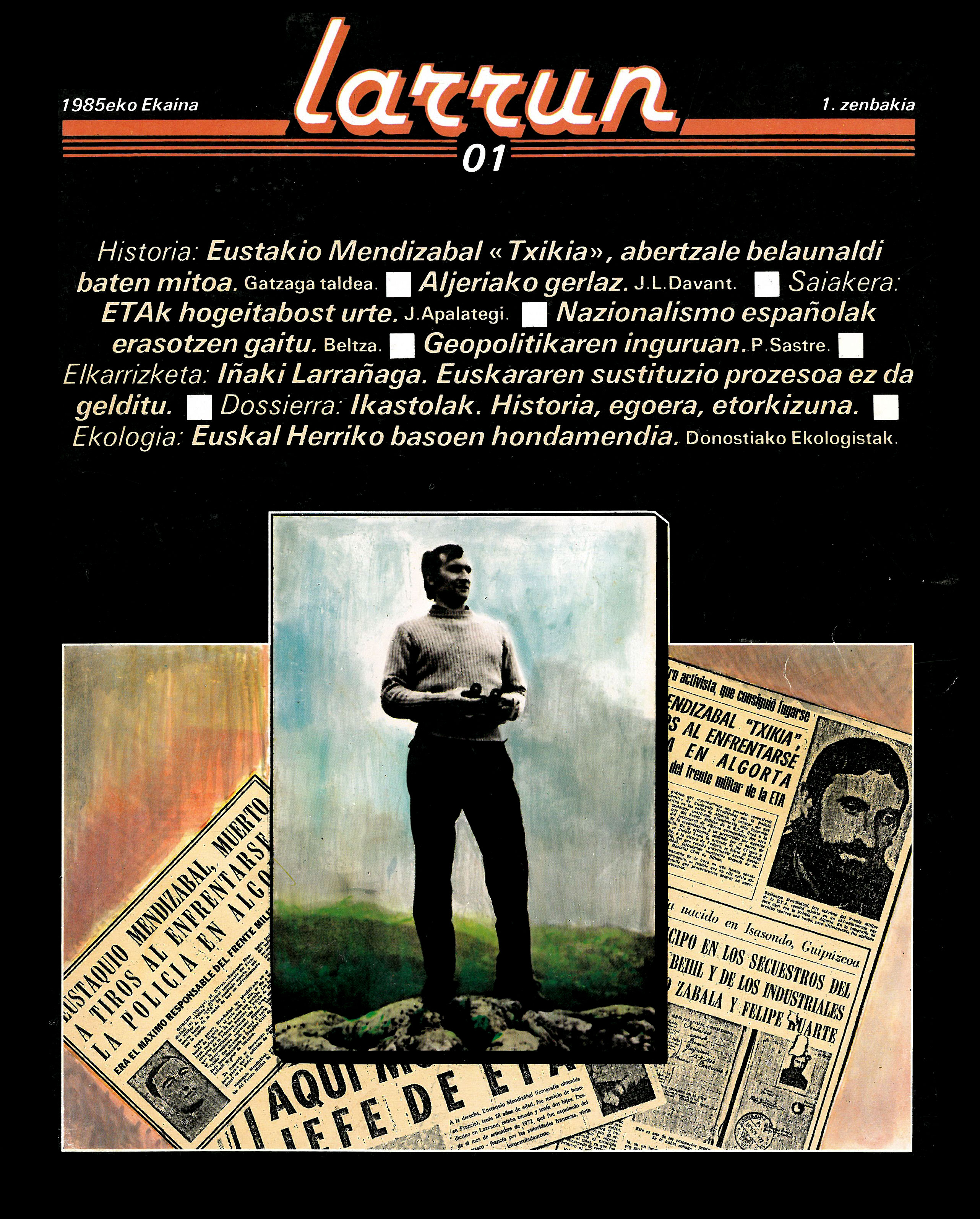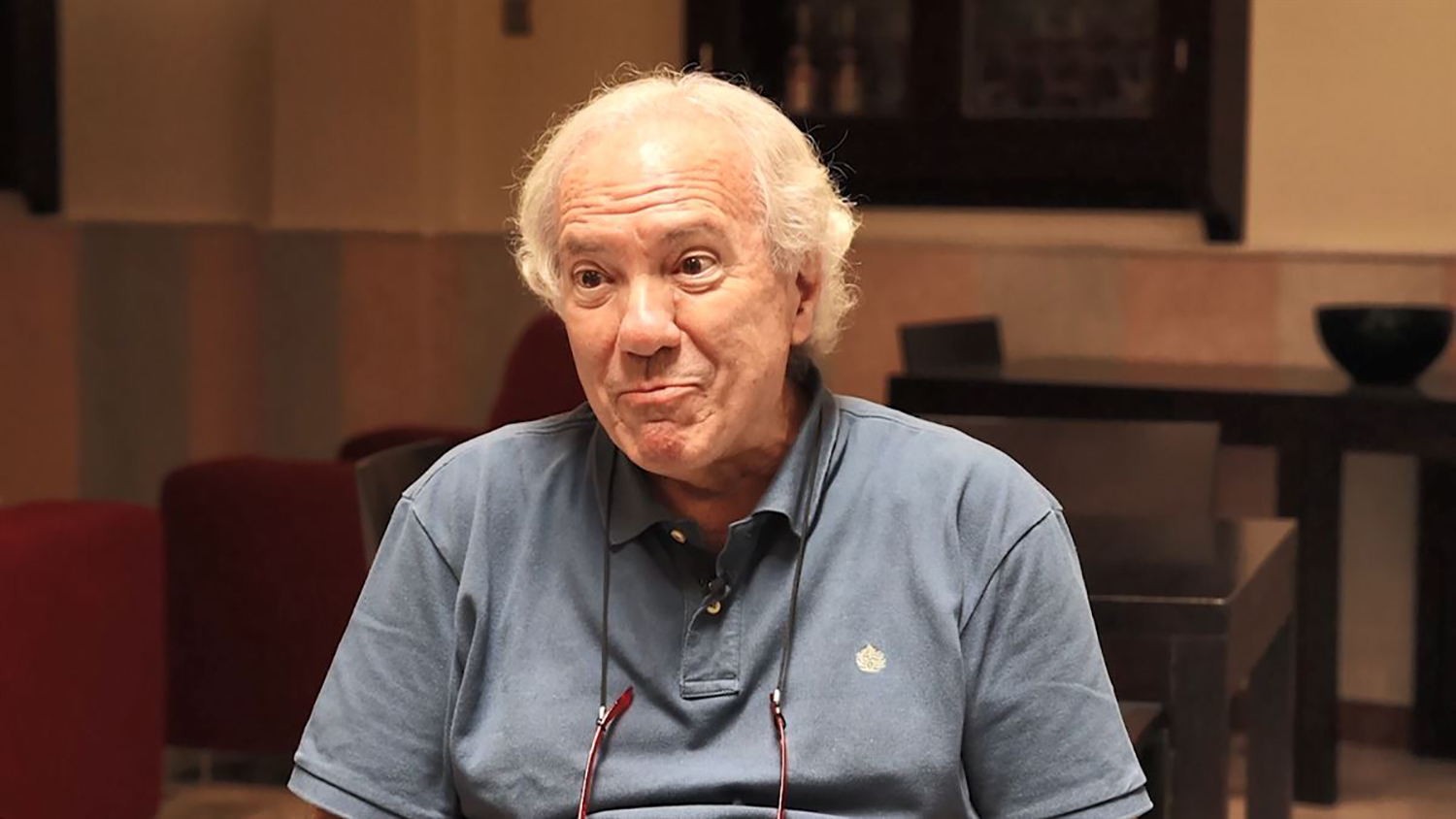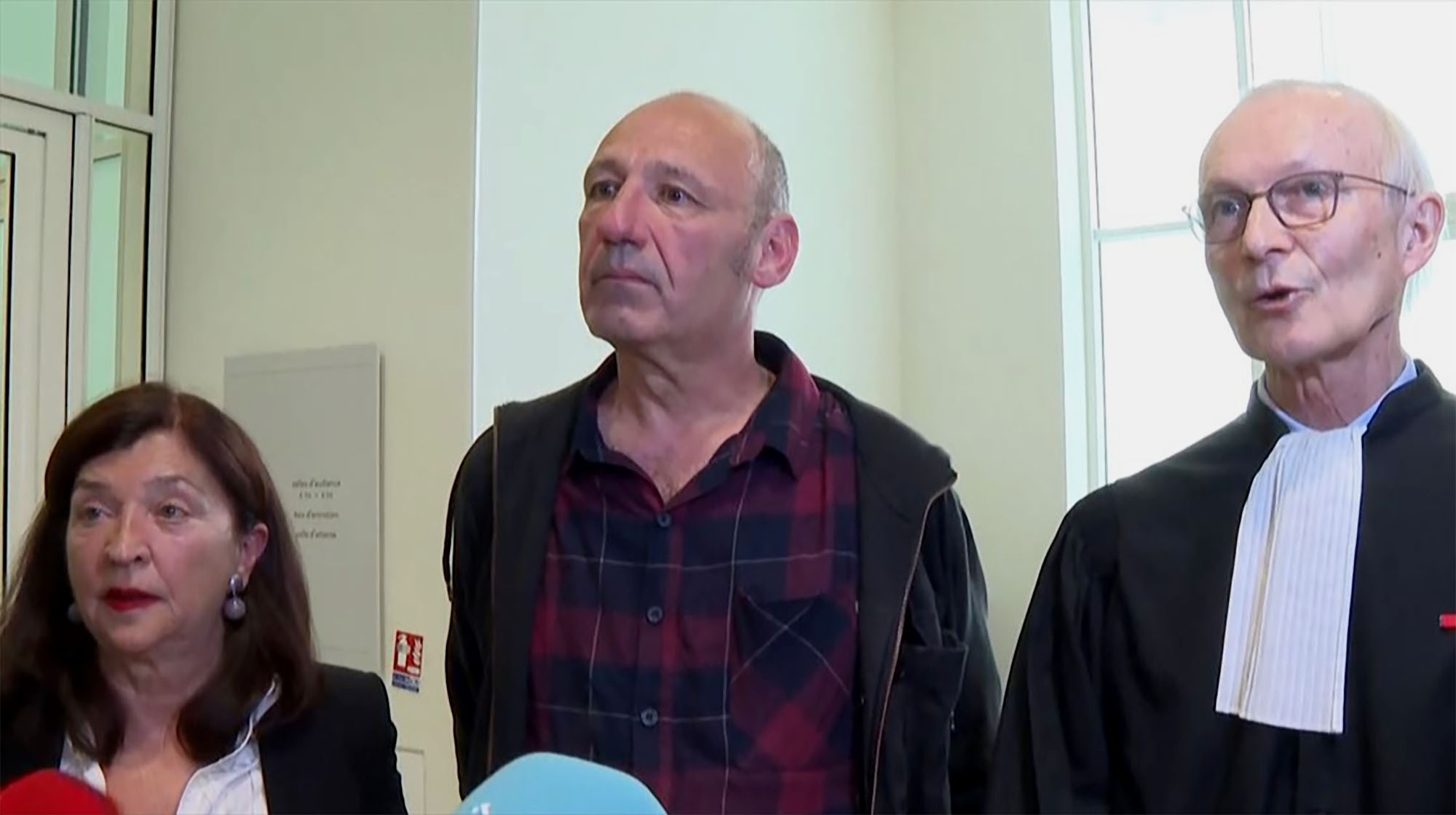Eustachian Mendizabal 'Txikia', myth of a generation of Basque nationalists
- Holy Thursday 1973 will last a long time in memory of many Basques. The day of Txikia's death became a myth of Basque armed resistance. Eustachian Mendizabal, the best known head of the Basque Military Front Ta Askatasuna, perhaps the most charismatic of the time, fell in the shooting of the Spanish Benito Police on April 19 in the streets of Getxo. He was twenty years old and became the point of reference for a whole generation of young Basques of four and a half years of clandestine work. The fact that her Basque instinct, her attractiveness and her courage did something special in the life of the Little One leads us to one of the most interesting stages in our history of recent years: the consolidation of ETA with action.
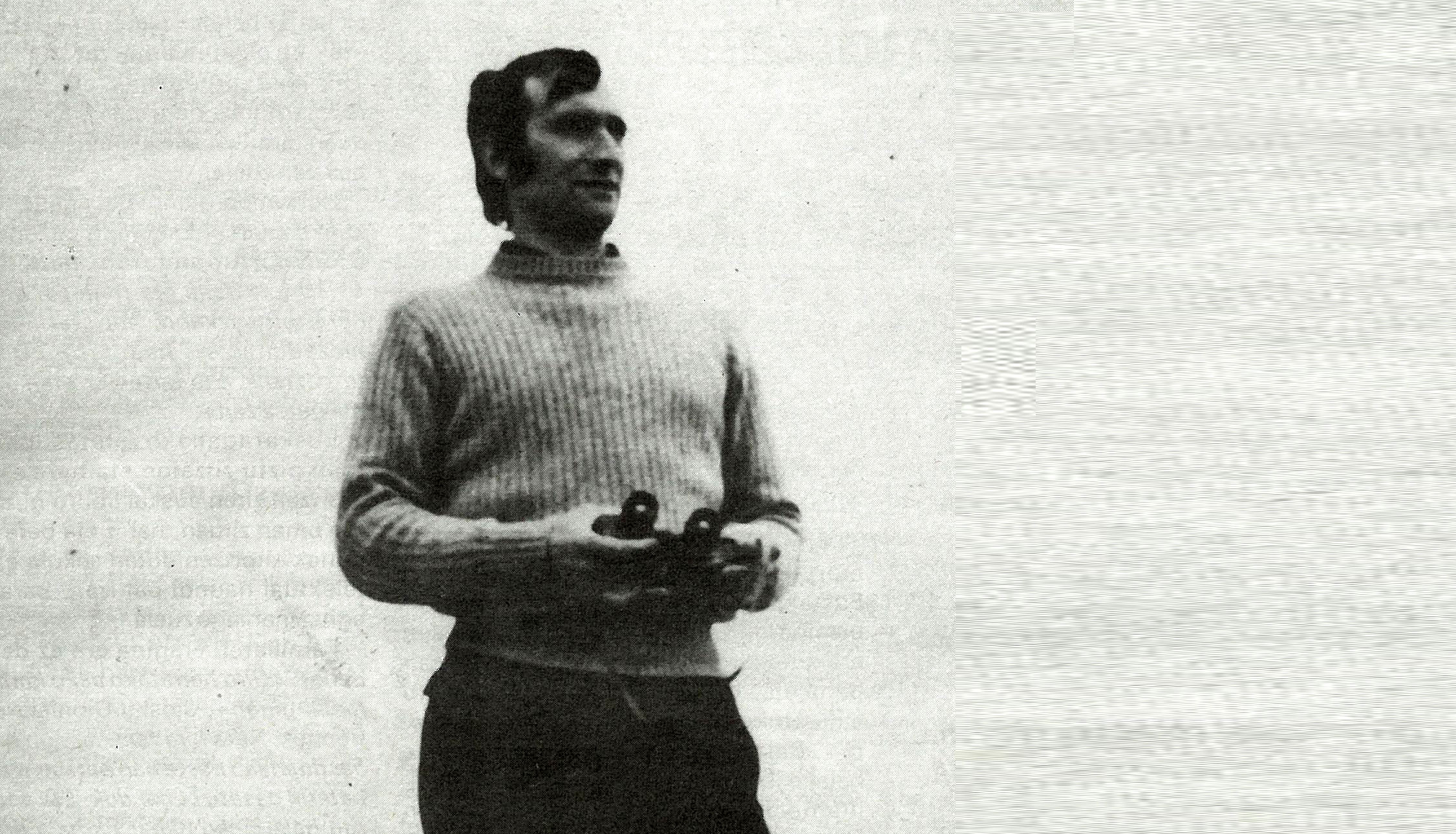
Eustakio Mendizabal is amidst the toughest and yet expected moments of the most important novelty that has occurred in the Basque Country in recent years, the Basque organization Ta Askatasuna. Fleeing north in 1968, his clandestine years captured by a famous Burmese lawsuit and the preparations to assassinate the head of government of Carrero Blanco Franco. For the first time he met the prison for one of the masses organized after the death of Txabi Etxebarrieta.
But Txikia has not been immortalized by coincidences. For many, being Eustachian the leader of ETA, he himself largely established the seal of activism to the organization. The kidnapping of the German consul cow, the kidnapping of Huarte, the preparation of the attack he was going to drive to Carrero... but he also got a kind of shadow in the plain people, sometimes he helped the militants in "something" and also in ordinary people who commented on their manifestations.
A Basque, Che Guevara, is seen by many in Txikia. Some mention their similarity to Zumalacárregui. There are also those who have seen the man coming out of the Benedictine and remain an idealistic Christian. Anyway, the warrior who did not leave his political thought in any book is worthwhile in history at least a couple of pages, as Telesforo Monzón sang “... for our children to learn their names in the ikastolas of tomorrow, which for the People died”.
Itsasondo to the convent of Lazkao
Eustachian Mendizabal was born in Itsasondo on 9 October 1944. Three of the 4 sons of Joxe Mendizabal and Josefa Benito were going to study the convent of the Benedictine in Lazkao, just as it had become tradition in those times and in later years in the Basque peoples.
He is cited as a very normal and ordinary child by those who then met Eustachian. Small, silent, who in his studies did not excel either up or down, and passionate about sport. When he entered Lazkao in 1954 and left in 1967, it could be said that he lived very closely the most “salty” environment the Basque clergy has known.
Benedictine Dionisio Amundarain, current director of the Basque School of Lazkao, is aware of this. “In these years Lazkao had about 130 friars and friars, of which about 30 were from masses and about 20 were from young people. And at that time the Basque atmosphere was full.”
His fondness for the Basque was unleashed in the convent and devoured all the Basque books that fell to his hands, although his friars recognize that he was never a great intellectual, he preferred to work in the garden.
Nor should we forget the influence of the family. "Many of these environments were children of Carlists," says Benito, brother of Dionysus, "and when he has to break with his family, he has to go through a crisis in order to address another. And you stop. It has to be said that, however, this was not the case of the Eustachian: his father has always been nationalist, even in times of war."
The turning of the 60 reaches the convents
The Benedictine older than Eustachian learned Euskera on their own, but there were classes for their time and they also performed theatres. However, the interior atmosphere of the convent would not be strictly Vasquist. At the time of the meal the friars heard the reading of a book (apparently today too), and the other Benedictine raised it as soon as Eustachian managed to introduce the Basque ones.
He followed, however, on his own and for the children of the institutes and centers of the area (only for the boys), as classes were taught, the small Basque Country and dotrine or history, in Basque.
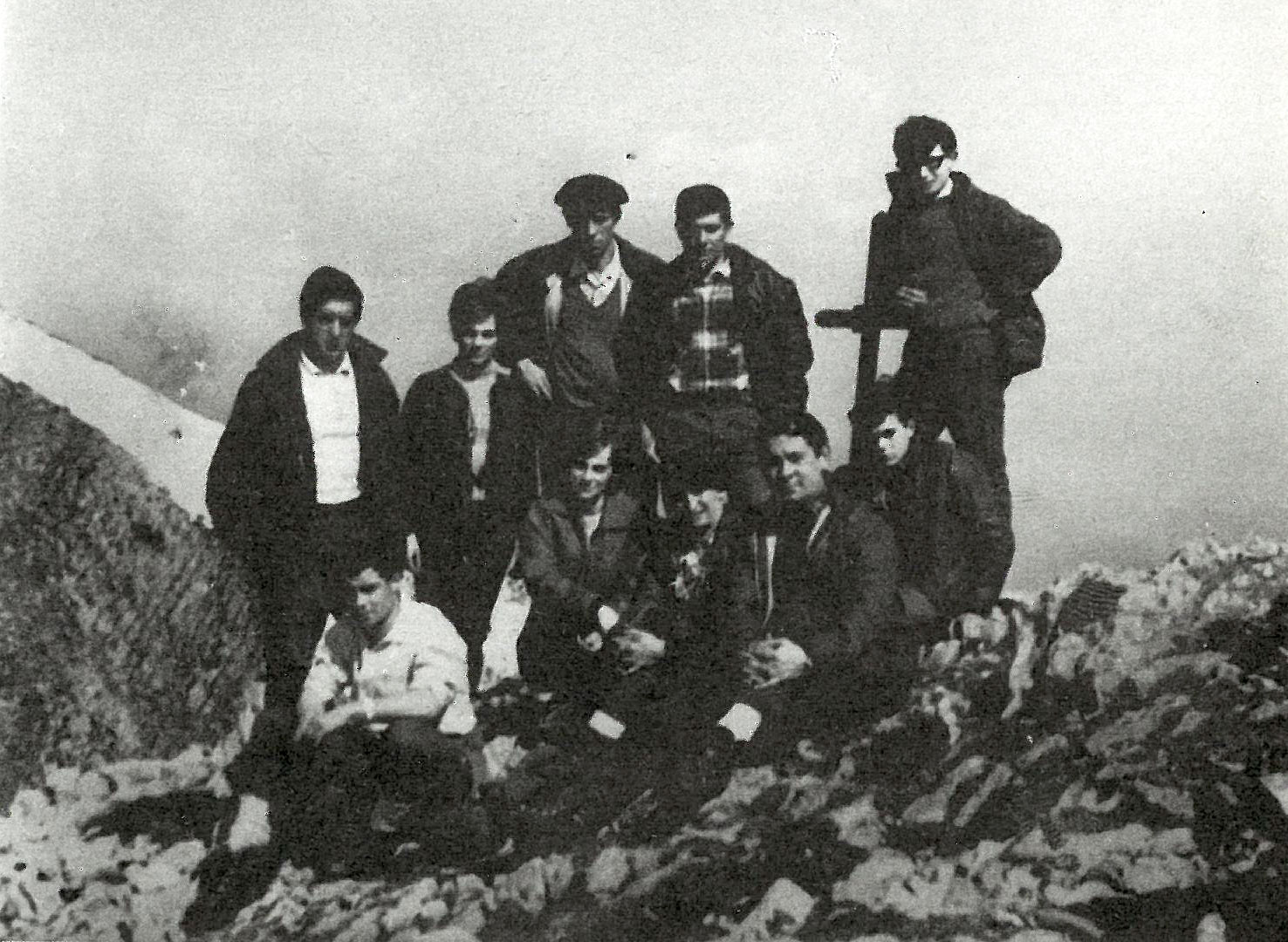
Meanwhile, in the 1960s, the street environment came to a standstill. The movements of young people and workers came into force. Juventudes Obreras Catholic (JOC). more inclined towards the laborer, concerned with internationalism and therefore, on the one hand, Herri Gaztedi on the other, linked to the national problem, the Basque, etc. There was also a third party, Vanguardia Obrera Joven, near the Jesuits and Commissions Obreras and further away from ELA.
Then there were all the dynamics produced by the ETA phenomenon, meetings as propaganda and, ultimately, solidarity with the deceased militants over time. "A lot of young people were approaching Lazkao," says Dionisio Amundarain, "and the multicopist was also here. At that time, the multicopist was a huge weapon."
Aggravation of Etxebarrieta's death
But there were more young people in “something” than what was seen from the outside. And when ETA lost its first militant in Benta-Aundi, Txabi Etxebarrieta, in his attempt to leave Tolosa, surrounded by the death of the Civil Guard, an unexpected movement emerged: the masses for Etxebarrieta.
A Mass was also organized in Lazkao and at the time of the Mass a plantation was presented in the church by the "Guerilleros de Cristo Rey" group. They went up into the choir and from there they were yelling “Goggles!” and “Pals!” to those who had the courage to appear in this form of protest. Meanwhile, a friar who was mightened in a corner of the choir heard a sound next to him: Eustachian, coming down with an ikurrina in the tower.

Eustachian had to make a one-month stay in Martutene prison in order not to pay the fine imposed on him by the Civil Government for participating in a Mass or manifesting. And also in Martutene teaching Basque classes.
From then on, Eustachian stayed for a short time in Lazkao and requested a year of experience in the convent, when he had barely completed theological studies to give Mass. He found work in Bilbao, where he worked in a naval factory, in Franco-Spain, from 67 to early 68. Once his facet is abandoned, he goes to work in a Beasain workshop and at the same time starts his Magisterium studies.
But when a friend is arrested, police officers soon appeared in his house. The police had 24 hours in the barking house: he was an abandoned man.
Woman, children and not going to church
For a season he was hidden in the Benedictine convent in Alentbaliz, until he found an opportunity to cross the Bidasoa. And there he spent a year at the Beloke Convent. “Those who fled,” reminds Benito Amundarain, “gave them a very cheap place of living and maintenance in Beloki, where we formed a group between the friars, the old and those we had never had.” Eustachian met many refugees in Beloki for five months, including ELA vice-president Leunda.

Once it was located in Baiona, it would settle in a buhardila there with four other fugitives. If the current residents of the Northern Basque Country are seen by the French administration, their situation was not at all comfortable either. "Travail Charte" gave them very little and many times they had to change jobs. The little one is found in the pictures of hunger strikes.
There she settled with a young woman from Ondarroa, Anabel Zubikarai. They would not marry, however, from the church, even though this decision generated many conflicts around, and their two sons, Matalaz and Ekaitz, were the first to go unbaptized in the Basque Country.
He wanted to make his attitude to religion clear, eliminating the reason for those who believed that he had remained a Christian since then.
After excision, ETA should start almost zero
Those who formed the core of ETA's "miles" had a thymic factory in a small village around Donapaleu and Eustachian went to live with them. The North got to know each other well and its nationalists remember Txikia, who was still with his green gabardine and many times in a molette.
He was arrested twice by the French police, both in the border area and with arms in both. On the second occasion he also met the prison and, released by the Pau court, spent two months hidden in a house in the south. Soon it fell.
As in the South, in Iparralde, he had a very special personality to put Basques to work. "It had the dimension of silence," explains both in the armed struggle and in life José Manuel Pagoaga "Peixoto", who knew Eustachian so much. "It kept the ways of talking, the brushes and all, of the old Basque. I had a great peculiarity with the older ones. Moreover, I would say that all the people I met at that time in the institution were brought by it.”
And ETA needed a lot of people. If this need is eternal, in addition to previous falls, tensions and excitement with those of the LV condemned the organization to almost start from scratch. Betting on those who would then be divided into Marxist-Leninist "minos" and Mayans (because they constituted the majority) Troskists left almost alone at the military front.
One of the freed in the time of the Little remembers the wager the miles had to make. “Imagine the criticism they received when they kidnapped the German Consul Cow, a kidnapping related to the famous Burgese cause, to the extent that he was convicted by some of the prisoners being prosecuted, when they committed the kidnapping of Huarte. However, they risked and showed that some minority activists were not; it was a system and not a popular movement that suffered a blow. And they got it right."
Eustachian's sleight amidst the contempt of 'Puto mili'
The works of the liberates from the 1970s would not be similar to the current ones, since, like the organization, the situation was very different. This is explained to us by the former liberated party we have mentioned. "You had an agenda and you had to spend so many times a month on the points where the groups were, make contacts, move to the groups a theoretical and logistical material, solve the problems that appeared, etc. Then there were social schools.”
During those 1966-67 years the Social Schools worked, and in 71 there were attempts to resume, but they were in crisis, amidst the crisis brought by ETA. These Social Schools taught subjects such as the history of political ideas, dialectical materialism, historical materialism, the economy...
ETA was in crisis and to a large extent its roots lacked the millennial confidence of the militants who came from the labor movement. In the midst of very intense ideological and political debates, the figure of the mile became despicable in different left-wing environments.
“Those of the sixth called him “mili slut” to sink a guy,” says the former militant who lives today in the South. "Eustachian ruptured this scheme, because it was not an undetermined "mili slut", taking into account class oppression, proposed to boost the Workers' Front..."
His area was from Tolosaldea to Irun
The military apparatus was personified by Eustachian for those who worked within it. “I would tell him that many times he was the one who, in a debate, would definitely tilt the balance.” He often relied on others for pure existence. And the former liberated military organization tells us an anecdote that he saw.
Some militants who came from the working class in a pre-assembly or pre-assembly raised a point as object of study: the need for armed struggle is recognized, but at a given moment the masses must be subordinated, or even the armed actions must be stopped.
Someone with a lot of strength in the organization did not put his face very good and Eustachian calmed things: “You... quiet. If one day we are told to stand, they will stop us. Twice as well. For the third time as well. From there we will see.”
But the Little Man was not only a man of direction, most of those who know him know him of his works and adventures “inside” (in the South). It was the area from Tolosaldea to Irun. If he focused the resistance struggle on military organization, a precursor focus of the dynamic was needed.
And in his area he tried to do it. The strongest actions were also carried out in that area, and for some actions, such as the burning of the Francoist union headquarters in San Sebastian, Eustachio also included those of other regions.
All Che Guevara's works in her library
In this attempt to strengthen a combat nucleus, the classical division of fronts in his valley was broken. “You are a militant, because there were these works and points,” says one that worked in the Donostia area. “And so it was possible to organize general strikes, Orbegozo strike, etc.”
For Peixoto, and recognizing that Txiki’s approach was not theoretically formulated, he organised a small KAS in that region. ETA’s strategy was not as coherent and clean as it was to be. And he sees it as a tactical conception.
But one reason to understand this is that he had the opportunity to know his library.
In the house of the little one, Peixoto found the accomplices of Che Gevara, “The War” of Clausewitz, “Santa Cruz Apaiza” of Orixe and all the verses and songs of Auspoa.
"But knowing their behavior," says Peixoto, "it seems clear to me that he knew Zumalacárregui very well and chose his tactic, not his strategy, his tactic." Mao-Tse-Tung also read in London the life of Zumalacárregui. And the novelty of the Zumalacárregui war was not to do the guerrillas as some say. "Zumalakarrangi was the first to organically use guerrillas with the regular army. 25,000 men."
Matches between Zumalacárregui and Txiki
This is not the only thing José Manuel Pagoaga looks like Txiki with Zumalacárregui. In addition, both died in the Bilbao area and both had to find money in Bilbao to attack Madrid. It is known that Zumalacárregui wanted to go to Madrid when the sunflower of the war seemed a little appropriate for the Carlists to do that attack, but the most necessary thing Don Carlos promised him was to take Bilbao, because with him it was possible to take Madrid.

“He didn’t want to go to Bilbao either. And yet, he touched the stone. To play in Madrid you need a solid infrastructure and then you were preparing the ETA Blast Furnaces. He was in that with another and they didn’t lack some detail, he had gotten an escape car and the details were made shortly after Eustachian died, or Carrero’s robbery was also raised.”
At the root of all of them we have to see the origin of Eustachian Mendizabal, a small rural village. This is manifested in several anecdotes narrated by those who knew it. Silent, he wouldn't participate in a debate until he heard everyone else "But he had it in every way of being a hunter or a montane. When it comes to passing the river – of course it is talking about the Bidasoa – it would also be hidden in a hole like a cat and suddenly, with all the surroundings well looked, run!”
Where is the mountain?
The importance given to the mountain in those years goes the same way. As a refuge and place of assembly, a different importance was given to the forest, because in the direction of ETA many of them belonged to that environment.
Safety on the mountain. “Go anywhere and the first thing: where is the mountain? Even when we went to Bilbao, and where to flee? And notice that from those mountains you will reach Gorbeia. If it is later.”
Big cities were greatly afraid of these men for their clandestine work. Others, on the other hand, after the years José Miguel Beñaran, for example "Argala", would reach the head of ETA, in cities that moved perfectly. Also in Madrid, they said that working there was much easier than in smaller towns. The little one, however, had an enormous mountain virtue, knew most of the mountains of the Basque Country and a very hardened body. Thomas Pérez Revillaga, recently deceased by a bomb placed by the GAL, said that “Give me some boots, but like those of Eustakio, with motorsito”, went to buy boots.
It is also part of many others who have gone through the friar in that love for the mountain and the forest, and you only have to read the poems of Gandiaga. There will have to relate a Tejlard of Chardin with his work, with the influence he had on youth as in the Church.
The small Euskaltzale and poet
And the Basque was his vice. Anabel, his wife, says that if she took free time it was to read books in Basque. Same is true for Axular. “You know the atmosphere, the poteo here in the streets of Ondarroa. night environment, etc. And Eustachian never emerged as a fan.”
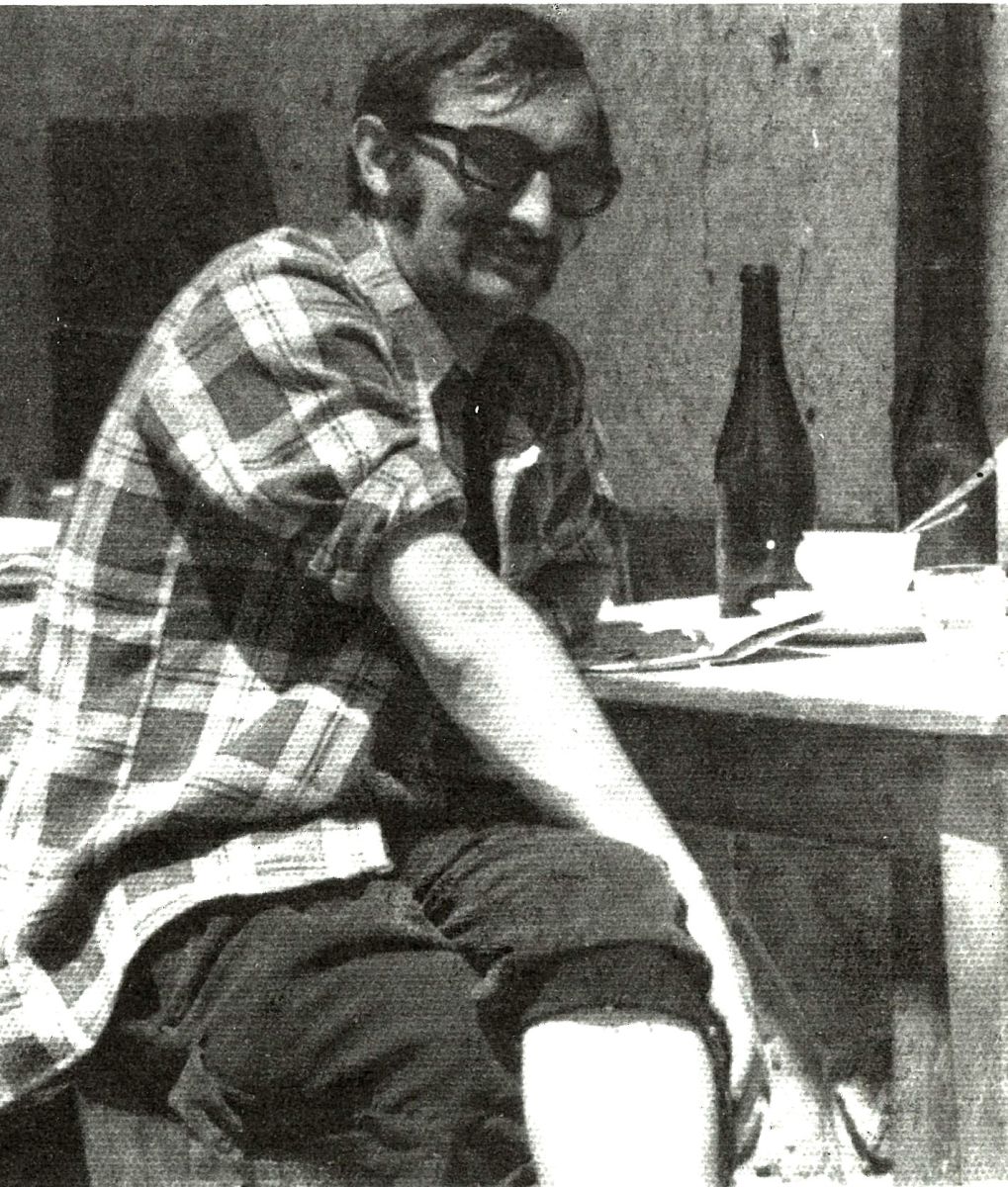
In his poems it appears that he read a lot of Euskera. As in Bizkaia, with the contributions of Iparralde, the sum of Euskera that was to be fixed after his death is very constant. Read the verses “Ama, txuko negarrak”.
It is unfortunate that that is what has happened to your writings. In his memory we have only one booklet with verses written in the Benedictine era and those published in the magazine “Olerti”. There was another lot, and certainly the most interesting ones, the writings when I was working underground. But all those materials that came together to make a book with their biographies and works have been lost. Unfortunately, all the efforts we have made to make their mark have been pointless.
However, the struggle of the Basque Country was not only a personal struggle, but was a condition to be in the direction of ETA. “The point is that we who had then were Basque speakers. And we spoke in Spanish when the Workers’ Front came and so on.”
Hunter intuition
From what has been seen so far, one of the main virtues of the Little can be extracted: intuition. Its “smell” is mentioned by all who knew it. This intuition saved his life on several occasions.
But at the same time one of those who met her in the direction tells us that it was very difficult to work with him. “One day I made him very angry and said to him, ‘You, Eustakio, you don’t have what you want to do here, listen?’ He stood up in white and white... and said nothing. He lacked the vacuum to give him an end.
But we went on and decided. There is always when to stop the protto and when to start. Running stops is always very difficult, as people don’t want to stay still. So we decided we would be quiet. The next day we go home. He gets up in the morning and I ask someone, ‘Hi, Eustakio non jak?’ 'E'txak'. 'Non kristo jak ba hori?'. ‘Leave a little papelite’. Under the door I had left a little papelito: ‘My men were depressed. Goodbye. My anger!
But when I came back, it was taken very well. He was very prudent in prioritizing and knew clearly the needs of the Organization. In this case, for example, let's suppose that in the drawer were twenty hard and the guy had returned with ten million. ‘Joder, hi, kristoren batxetik gaitxik’ and abuse’.
An obsession: the trust of the people
The strategy, in principle, was not fully clarified and concrete in ETA, acknowledged by the managers themselves. Franc alive and strong, almost immortal, how was it realized at that time what in a political strategy appeared in the principles?
Peixoto sees the political path of Eustaquio Mendizabal around two scripts: to be abertzale you need Euskara and even if it is abertzale and Basque, to fight for it, a real battle. And he would criticize those who went from the point of view of Spain who recognized the radical Abertzale and did not enter into a dynamic of struggle.
At the center of everything, the Basque. He was once asked in a group to see what the political framework of ETA was. "The political framework of our struggle? What gives language."
And with it the principle of virility. Virility, honesty. Build the trust of the people. His obsession was always “The people are mistrusting us.” As Iñaki Larrañaga, who knew of Itsasondo and did not miss any treatment later, said, “Hi, what do people say?”
Peixoto remembers the times when the organization was in the hole. "You had to be a man in every field to gain the trust of the people. It has been a constant of ETA for many years: to reclaim things, even if they are contrary, the truth is that ETA’s biggest capital today is its creativity.”
Action up to final limits
If he was removed from Christianity, he did not become a Marxist, although he was never anti-Marxist. Because I didn't feel a need. "To move forward here we have to do what the People feel, from there we will leave." Broad principles leading to extreme militancy.
In the Eustachian era, José Miguel Beñaran "Argala", a young militant with such weight in the history of ETA, would appear. At first, the former militants found the step from the philosophy of "Murder for the people" dogmatic, adding another: "win".
But the little one was more entrepreneurial than political and, above all, an absolute militant. But he's not a tough militant for "rampant" security, or for austerity of life.
The approach of the fronts established by the 5th ETA Assembly was followed. Four fronts and four that require violent confrontation. And the hardest struggle among the four is the navy, even though he understands perfectly well that others do other jobs.
But the fronts were peripheral to him, even the armed organization itself. Because the most important thing for him was to make a center. A focus, which would be the pioneer of dynamics. As Peixoto defines: “The direction would not be that of those who had ideals, but of those who carried that center of dynamics.”
"And then?" 'Borroka hil'.
In those five years a great deal of work was done, and the newspaper pages of that time are the best witnesses. The little boy moved like at home. Their parents recognize that they often saw it happen, sometimes giving up, sometimes covering their faces with the newspaper. Many people knew it.
On the other hand, he knew where he was going. He also smelled of death. Benito Amundarain tells how he found him one day in the Old Part of San Sebastian. “But what are you walking here?” “You know you have to walk and ...” And a little later “You, if one day I know... I have to kill it like this.”
Joxe Manuel Pagoaga account. "I, just fleeing, thought I wanted to see how we would win if I was going to risk my life. One day I went home and asked him what we had to do. ‘Now, after this campaign, another’. And I said, "And then?" More and more. ‘And then,’ and then, and suddenly, ‘And then?’ Die in combat’, thus, without changing the voice. Eustachian realized that he had to be killed. When we were a people, we had to release him... kill him in combat.”
But there were changes. And the consolidation of ETA in that change. Increasingly ambitious and risky actions. He had to enter Bilbao and Eustachian smelled badly. “They tell me that I know me here, but I also know him well. But in Bilbao, what, where to go, where to flee?”
He was so afraid of the damn Bilbao
In recent months, the police were pretty close. The last impressive getaway took place in Zumarraga, where he managed to escape with great luck and risking everything.
But you had to go to Bilbao. Carrero's operation was under way and others had to be specified, such as the Carnés and the Atras de Altos Hornos operation. However, the last day can be counted by Peixoto who was with him.
“The thing is that Eustachian calls me to Bilbao, I don’t know why. He puts me on a date in a bar in Rekalde, and there we get together a dozen illegal immigrants. And he tells me that I have to go with him.
We leave that bar, the whole Christ, Cllaro, and there come two black cars, the two 500, full. We saw them, of course they were dogs, but they didn't dare to do anything. They went ahead and -- each by their side. Eustachian and I to Matiko. So I met Matiko.
We entered a house and we ate there. There was a representative of the Madrid command, one of those who were preparing Carrero's. Carrero's action and that of the cards were discussed. And at six o'clock at Algorta Train Station.
Algorta, at 6 pm at the station
I was at Algorta Station at six, waiting for the train. Eustachian leaves the train, has come to me with his traditional green tabard, and about three meters does a sign with my mouth putting my teeth in this way. And from behind I see a group of men, but I have two faces in my head, the men of Christ, a tenth. I’ve stood before and Eustachian: ‘Ketozek persecutors’. "Are you sure?" ‘Yes, I’m sure.’ ‘Well, go the bear, see if they follow us.’ And they're always behind.
We went back and stayed by the portal of a house. Look back and by then everyone came online, openly, taking the path in all its extension, putting their hands like this in the deal (typical gesture of the bodyguards). And on Eustachian face was death, the key, the white mouth.
Suddenly, he breathed and we have to run! Start the race and the others shoot. I took the distance from the first blow to Eustachian, but then the head doesn't work, I think, the instinct works and I stopped him to wait for him.
We would run forward, we would walk about forty meters, and I saw some stairs on the right, and the road went after a mountain cut. I took the stairs, went up at a speed and up, through a drawer, looked and saw for the last time Eustachian, very close to the others and pulling.
From the bottom up I saw them from the back, and I walked up the stairs, I went back to the same street, I entered a frost and threw a brown jacket that Garratz gave me, and I went out. Jacket -- in the morning I laughed at Eustachian: 'If you are too, with those Holy Thursday and some clothes with that torrid shamardo'. She was also not kidding and: ‘She also has clothes to walk on Holy Thursday’.
I took a car and walked into a house. And when that car was in a traffic light, it passed an ambulance to Bilbao. "Finally, I thought Eustachian. Until they started the shooting and saw the ambulance pass through the traffic light, it didn’t take more than five minutes.”
ETA’s qualitative leap in the Txikia times
The following day, Good Friday, all the newspapers highlighted the death of the Little. The newspaper “El Correo Spanish-El Pueblo Vasco” thus titled “Eustaquio Mendizabal, shot at random to the police in Algorta. He was the head of the military front of T.A.”. The French-Basque area eagerly awaits Spain’s entry into the E.C. Bayona ez du arrinconada eta portua zabaldu. Guipúzcoa, Alava, Navarre and Vizcaya have the airport of Biarritz-Parme”. The rest of the newspapers also featured as head of Eustachian. “The Northern Gazette”: “Here died the head of ETA.”
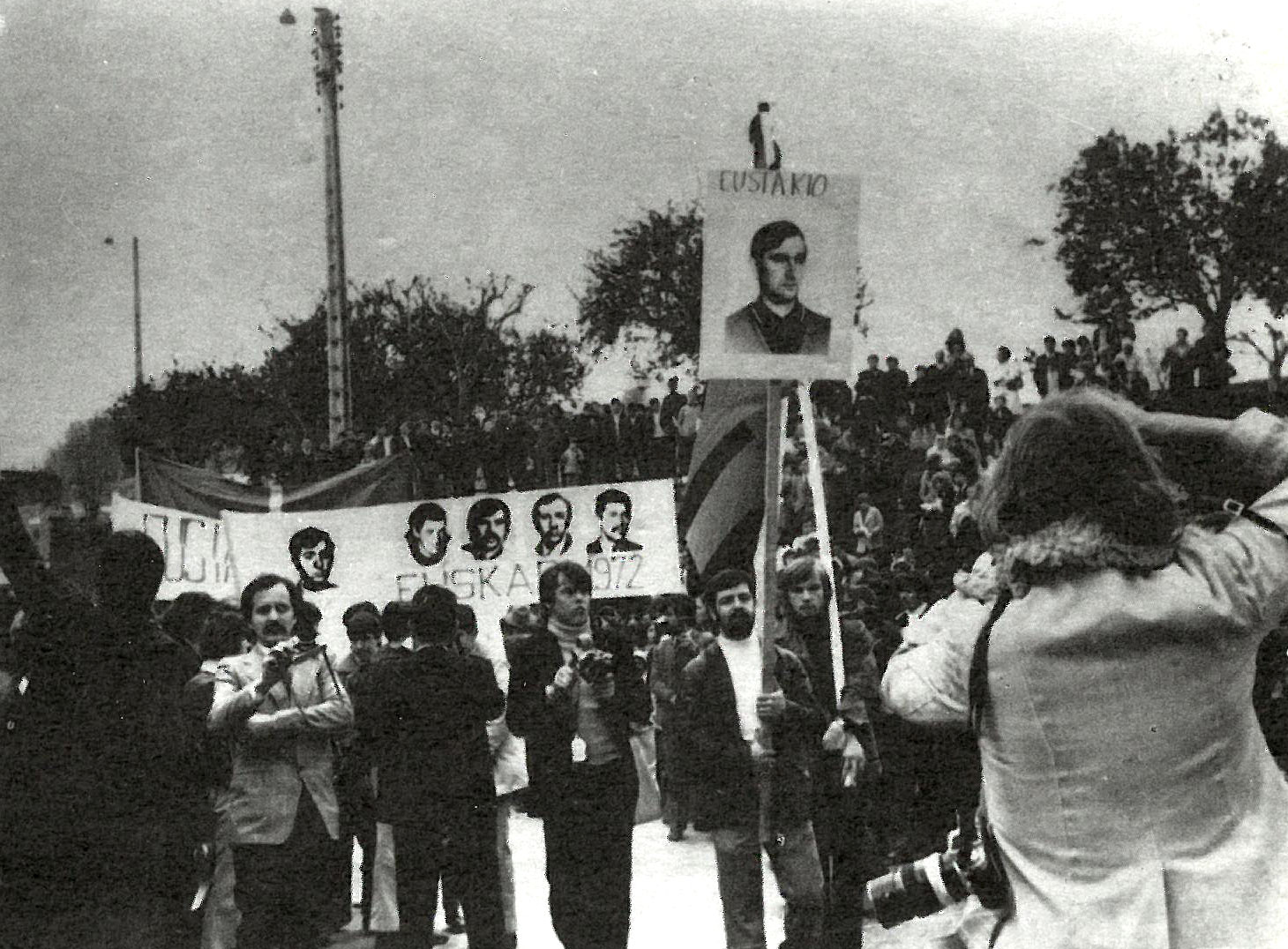
It is not easy to know who is the leader and the weight of each militant in the organization, in an organization that keeps so much secrecy. But the importance of Txikia has become clear. Moreover, after his death you can see a decrease in the actions.
At the time when Eustakio Mendizabal was active, ETA made a qualitative leap in its manifestations. The kidnapping of the German consul cow, the kidnapping of Zabala (the first time a Basque was kidnapped), that of Huarte, the burning of the unions, the robbers of the Orbegozo and Pasaia truck, the transfer of the dynamite from the Hernani quarry... and most of the actions take place in the region of Oreras to Tolosa.
Small to Slim
Besides having overcome the police tactics for a while, the effect of the acceleration of actions was felt everywhere: in the labor movement discussions took place, the Church made a commitment to give an interpretation of the facts. At European level, the Basque national problem had an extraordinary impact, and with the rapprochement of journalists, solidarity commissions were set up. In 1975 they would have the opportunity to show their support for the firing of Txiki and Otaegi.
A former militant in Txiki’s time tells us one more step that ETA militants have to take at that time. “The possibility of death became real for us with the murder of Eustachian. The police were also studying, and if you look at the Little Girl’s deaths and the ones that happened to him, you will realize they had an order to kill the liberates rather than stop them.”
As with the death of Txabi Etxebarrieta on the street level a strong angry reaction, in Txikia the feeling of grief and impotence was greater. The fall of a myth. ETA's actions also decreased, at least in number, as in the following months there were more falls and deaths: Norte, Artetxe... but its influence would have remained qualitatively, trapping one of the highest points with the famous Carrero wave.
Soon we will find another of the most important men of ETA, José Miguel Beñaran Ordeñana "Argala", completely different from the son of Itsasondo. But as he will add dynamic organization and fast speeds.
* Report signed by Pello Zubiria and Joxemari Ostolaza as Gatzaga Taldea.
Felipe Gonzálezen garaian Espainiako Barne ministroa zen José Barrionuevoren aurkako kereila aurkeztuko dute, Ipar Euskal Herriko errefuxiatuen aurka abiatu zuen estrategiagatik. ZEN Zona Especial Norte Planaren barruan egindako ekintzen erantzule nagusietako bat... [+]









